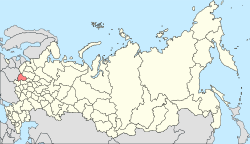Katyn (village)
| Katyn (English) Катынь (Russian) |
|
|---|---|
| - Inhabited locality - | |
 Location of Smolensk Oblast in Russia |
|
|
|
|
|
|
|
| Administrative status | |
| Country | Russia |
| Federal subject | Smolensk Oblast |
| Statistics | |
| Population (2002 Census) | 1,737 inhabitants |
| Time zone | MSK (UTC+03:00) |
| Founded | 2007 |
| Postal code(s) | 214522 |
| Dialing code(s) | +7 481 |
| on | |
Katyn (Russian: Катынь; Polish: Katyń [ˈkatɨɲ]) is a rural locality (a selo) in Smolensky District of Smolensk Oblast, Russia, located approximately 20 kilometers (12 mi) to the west of Smolensk, the administrative center of the oblast.
It is situated to the west of the city of Smolensk (about 18 km from its center) and circa 60 km from the Russian borders with Belarus. It has a station on the Berlin-Warsaw-Minsk-Moscow international railway line.
Before World War I, Gnezdovo with the Katyn Forest belonged to the Koźliński family. In the 19th century, Piotr Koźliński married Leokadia Lefftreu, the daughter of the director of the English railway construction company in Russia. Under the marriage articles Gniezdovo and Katyn became a co-owned by the British.
The Katyn Forest in the vicinity of the village was the site of the Katyn massacre during World War II, in which thousands of captured Polish officers and other citizens were killed. Despite claims by the Poles, the Soviet Union blamed Nazi Germany for the mass murders and attempted to hide their involvement, going as far as to ban all mention of the Katyn massacre in the USSR. Then in 1990 Mikhail Gorbachev admitted that the NKVD had indeed executed the Poles and confirmed two other burial sites similar to the site at Katyn: Mednoye and Piatykhatky. A number of earlier mass graves of victims of the Soviet system have also been found there, as Katyn Forest had long been used as an execution site for Soviet citizens.
...
Wikipedia

